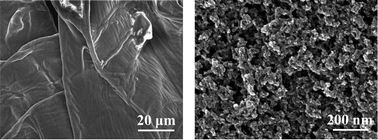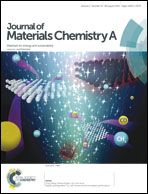Biomass derived hard carbon used as a high performance anode material for sodium ion batteries
Abstract
A porous hard carbon material was synthesized by the simple pyrolysis of H3PO4-treated biomass, i.e., pomelo peels, at 700 °C in N2. The as-obtained hard carbon had a 3D connected porous structure and a large specific surface area of 1272 m2 g−1. XPS analysis showed that the carbon material was functionalized by O-containing and P-containing groups. The porous hard carbon was used as an anode for sodium ion batteries and exhibited good cycling stability and rate capability, delivering a capacity of 181 mA h g−1 at 200 mA g−1 after 220 cycles and retaining a capacity of 71 mA h g−1 at 5 A g−1. The sodium storage mechanisms of the porous hard carbon can be explained by Na+ intercalation into the disordered graphene layers, redox reaction of the surface O-containing functional groups and Na+ storage in the nanoscale pores. However, the porous hard carbon demonstrated a low coulombic efficiency of 27%, resulting from the formation of a solid electrolyte interphase film and the side reactions of surface phosphorus groups.


 Please wait while we load your content...
Please wait while we load your content...